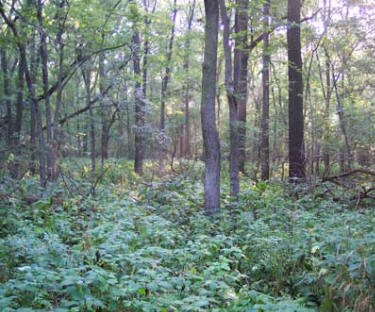 Situated in the middle of a university town in central Iowa, there exists a hotspot for neotropical migrants. A variety of flycatchers, vireos, thrushes, and warblers visit this wooded sanctuary while traveling to and from distant wintering grounds. At first glance, though, one might deem Brookside Park to have little wildlife habitat. Indeed, the various pavilions, playground structures, and sports fields visible from the entrance seem to belie a place that holds multitudes of songbirds in migration. However, this popular park does, in fact, harbor valuable bird habitat beyond the more traditional components.
Situated in the middle of a university town in central Iowa, there exists a hotspot for neotropical migrants. A variety of flycatchers, vireos, thrushes, and warblers visit this wooded sanctuary while traveling to and from distant wintering grounds. At first glance, though, one might deem Brookside Park to have little wildlife habitat. Indeed, the various pavilions, playground structures, and sports fields visible from the entrance seem to belie a place that holds multitudes of songbirds in migration. However, this popular park does, in fact, harbor valuable bird habitat beyond the more traditional components.
Various elements contribute to Brookside’s attractiveness to birds. Squaw Creek, which passes through the eastern part of the park, appears as a ribbon of trees in a predominantly open landscape outside the city. More heavily wooded than much of central Iowa, this riparian stretch swells to a sizeable block of floodplain woods at the north end of Brookside. Upstream, two other riparian belts feed into Squaw Creek, while the larger Skunk River corridor lies just a short distance to the east. Ames itself is a comparative haven of trees in this part of the state, with Brookside positioned as a vital element of the city’s greenbelts.
Due in part to its centralized urban location, the park has thus far avoided the fate of many other Iowa woodlands, whose understories have been browsed into submission by deer. By the same token, invasive shrubs like bush honeysuckle (Lonicera spp.) and multiflora rose (Rosa multiflora) are less common here, allowing more desirable plants to flourish. Hence, location and even site quality may contribute to the park’s status as a prominent migrant trap.
Another significant woodland is preserved along the Clear Creek greenbelt in west Ames, and there are many other areas in town that produce interesting birds. Few offer the convenience and easy navigation of Brookside, though. Most of all, we know so much about how to bird the park based on the considerable amount of data collected there in recent years. Comprehensive studies of warbler migration at Brookside Park, conducted from 1982 to 1986, helped to further our knowledge of the seasonal abundance and distribution of warblers in Iowa (Martsching 1986, 1987). In fact, some of Martsching’s peak counts and early/late migration dates still endure as standards. His studies also solidified the park’s status as a migration hotspot –– one worth monitoring on a yearly basis. In that regard, Fix (1990) described a remarkable Point Pelee-like experience at Brookside on a flooded day in May. Additionally, many of the park’s interesting sightings are archived in The Birds of Story County (Dinsmore and Zaletel 2001) and Birds in Iowa (Kent and Dinsmore 1996), as well as in seasonal birding publications (e.g., North American Birds).
DIRECTIONS TO BROOKSIDE PARK
The entrance to Brookside is located along 6th Street in central Ames, immediately east of Elwood Drive and several blocks west of Grand Avenue (Figure 1). To reach this area, begin with U.S. highway 30, which serves as an expedient artery through south Ames. Exit north from this divided highway onto Elwood Dr., and then follow Elwood up to 6th Street. After making a right turn at a traffic light on 6th Street, Brookside Park will be on your left immediately following a railroad underpass. This is a surprisingly direct route that allows access to the interior of Ames, without the added hassle of mid-town traffic. (This route is less advisable on days of Iowa State University football games or other events that lead to concentrations of traffic along Elwood Dr. In such cases, use Grand Avenue by way of 13th Street, which connects to Interstate 35. Heading west on 6th Street from Grand then leads to the park’s entrance.) After entering Brookside Park, turn left and proceed past several baseball diamonds around to a final parking lot. From this convenient position, you can start birding as soon as you step out of your vehicle.
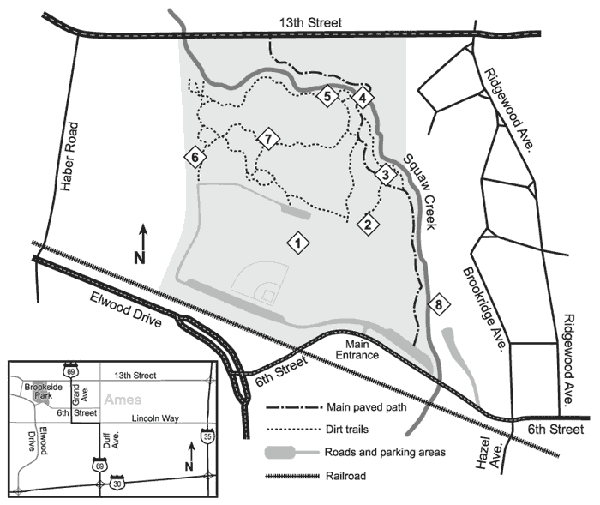
Brookside Park in Ames: (1) shade trees and semi-open area, (2) dense southeastern edge of woodland, (3) meadow and riparian thickets, (4) northern footbridge environs, (5) island overlook and western extent of creek-side trail, (6) park/pasture border, (7) inner woodland trails, (8) southern footbridge vicinity.
SPRING AND FALL MIGRATION
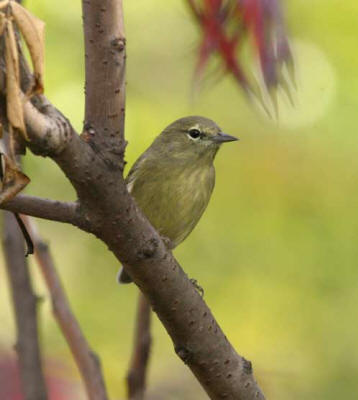 Spring (April–May) and fall (Aug–Oct), when songbirds are on the move, offer the best times to bird Brookside Park. One way to begin a spring/fall walk is to explore a nice stand of oaks beyond the parking lots and baseball fields (Figure 1.1). These trees, with their sprawling, irregular branches, allude to the savannas that once covered portions of central Iowa. Although devoid of a developed understory, this oak grove, along with an assortment of hickories, hackberries, maples, and ash, still features waves of songbirds in spring and fall. In particular, look for upper-canopy dwellers like Blue-headed Vireo, Blackburnian Warbler, Bay-breasted Warbler, and Blackpoll Warbler, which can be easier to view here due to the semi-open nature of the habitat. The scattered hackberries seem to be especially attractive to kinglet-dominated flocks in fall. Sifting through these dynamic bunches sometimes reveals rare late-season warblers and vireos. Given the proximity to the parking lot, the area is worth at least a quick inspection before exploring the woods and streamside.
Spring (April–May) and fall (Aug–Oct), when songbirds are on the move, offer the best times to bird Brookside Park. One way to begin a spring/fall walk is to explore a nice stand of oaks beyond the parking lots and baseball fields (Figure 1.1). These trees, with their sprawling, irregular branches, allude to the savannas that once covered portions of central Iowa. Although devoid of a developed understory, this oak grove, along with an assortment of hickories, hackberries, maples, and ash, still features waves of songbirds in spring and fall. In particular, look for upper-canopy dwellers like Blue-headed Vireo, Blackburnian Warbler, Bay-breasted Warbler, and Blackpoll Warbler, which can be easier to view here due to the semi-open nature of the habitat. The scattered hackberries seem to be especially attractive to kinglet-dominated flocks in fall. Sifting through these dynamic bunches sometimes reveals rare late-season warblers and vireos. Given the proximity to the parking lot, the area is worth at least a quick inspection before exploring the woods and streamside.
The southern edge of the woodland, located right next to the parking lot, is a useful conduit to follow. Anywhere between the lot and the shores of Squaw Creek (to the east) can be productive. Along the border, check taller trees towering above the canopy and vine tangles at all levels. These dense sections often harbor some of the most diverse assemblages of migrants at Brookside. A consistently active spot is located north of an old fire truck, which is maintained as a distinctive playground component for the community. Just a few dozen feet from this truck is an accumulation of trees and vines that comprise a natural wall of vegetation along the woods (Figure 1.2). Warblers, kinglets, vireos, and flycatchers have foraged here in impressive numbers during migration. For springtime warblers, I have found this to be one of the best places to watch colorful singing males as they move in and out of various foliage layers. Be aware that much of the vegetation along this southern edge has been torn out in recent years to create additional room for spent lumber and junk disposal. Still, enough suitable habitat remains to make this spot worth double-checking during a warbler walk.
To the east, a wide paved trail enters the main woodland. Just beyond this entrance point is a small meadow along Squaw Creek (Figure 1.3). Both the dense shrubbery along the edges and the big trees in the meadow can yield mixed-species flocks. Also check the shoreline here for Northern Waterthrush, especially in spring. At the northern extent of the opening, a narrow dirt trail leads into the woodland. This continued stretch of riparian thicket often holds thrushes (including gray-cheeked), Gray Catbirds, Brown Thrashers, and other fruit-eating species during migration, in addition to serving as another place to find mixed-species flocks.
The dirt trail soon goes across the paved path and follows the creek’s course to the west. Before continuing forward on this route, search the vicinity of a large footbridge over Squaw Creek (Figure 1.4), which provides the best vantage point to scan the sky for raptors, especially Sep-Oct. Squaw Creek also serves as a temporary passageway for many other diurnal and crepuscular migrants, including aerialists like Common Nighthawk, Chimney Swift, and various swallow species. Besides the usual individuals foraging high above the city, Katy Patterson and I once watched a procession of Common Nighthawks in direct flight over the creek on an early September evening. One at a time they followed a resolute course, just below treetop level, staying far below their skyward counterparts. On an evening in May, we observed a Silver-haired Bat (Lasionycteris noctivagans) navigating slowly along this same corridor. A number of other bat species are found at Brookside, further hinting at the importance of the area to a variety of wildlife.
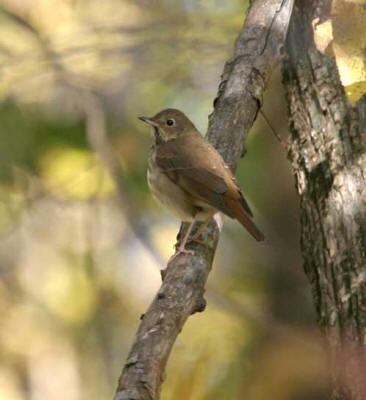 The trees and thickets near both ends of the bridge offer yet another location for migrant songbirds. From the bridge itself, look east to the highest snags along the canopy, where you’ll see a favorite perch for Olive-sided Flycatchers in May, August, and September. Interestingly, other treetop species are sometimes seen foraging at lower levels by the bridge, thus offering birders a temporary respite from “warbler neck.” And for a quick break, a park bench off of the east end is a relaxing place to observe birds in nearby shrubs and saplings.
The trees and thickets near both ends of the bridge offer yet another location for migrant songbirds. From the bridge itself, look east to the highest snags along the canopy, where you’ll see a favorite perch for Olive-sided Flycatchers in May, August, and September. Interestingly, other treetop species are sometimes seen foraging at lower levels by the bridge, thus offering birders a temporary respite from “warbler neck.” And for a quick break, a park bench off of the east end is a relaxing place to observe birds in nearby shrubs and saplings.
Returning west to the woodland dirt trail, you will soon have an elevated view of a grass-brush island that has been expanding its reach within Squaw Creek in recent years (Figure 1.5). Although typically inundated during spring floods, this ever-changing habitat patch provides shelter for sparrows and wrens, including Winter Wren, in fall. The upper shoreline here enables easy viewing of these brush-loving birds as they forage. This vantage point can also hold Northern Waterthrush, which seems to favor the more open segment of stream in fall. Additionally, above the eroded shoreline, you will find one of the better places for mixed-species flocks in both spring and fall. The big trees at this spot have served as the park’s most consistent spring location for Philadelphia Vireo. (Caution: the elevated bank near the trail is currently very steep. Please be careful. All of the habitats here and elsewhere in the park can be easily viewed without walking close to the edge. Squaw Creek’s erosion rates have reached unnaturally high levels in much of the park.)
Farther west along the creek, just before the trail bears south, is another productive area for songbird waves. What makes this little corner of the woods notable is its custom of attracting Golden-winged Warblers from late August to mid-September. Numerous thrushes, along with other understory inhabitants, are drawn to this quiet stretch of floodplain habitat. Nearby thick patches of jewelweed (Impatiens capensis) produce Mourning Warblers Aug-Sep and might draw in a rare fall-season Connecticut Warbler. The tubular flowers on these plants also harbor a preferred food source of Ruby-throated Hummingbirds in summer and fall.
As the path heads away from Squaw Creek, a horse pasture becomes visible to the west. This open area, while not part of Brookside Park (and off-limits to the public), can still be viewed from the trail, especially along the southwest section (Figure 1.6). Big trees along the edge attract mixed-species flocks, while thick grass near this park-pasture border often holds concentrations of sparrows in fall. Watch for Fox, Song, Lincoln’s, White-throated, Harris’s, and White-crowned Sparrows as they flush and perch in low branches. The assortment is similar to what is found at the island area, only in larger numbers here. Late in the day, when many of the sparrows are gathering to roost, is usually the best time to bird this pasture-woodland border, if you can avoid gazing into the sun. To the south, the trail concludes at the woodland edge, where a narrow line of thorny trees extends southward along the entrance road. Northern Mockingbirds have found their way to this dense fencerow on a few occasions in May.
On any spring/fall trip to Brookside, make sure to carefully bird the brushy, forb-rich trails in the heart of the woodland (Figures 1.7 and 2). Swarms of warblers, often led by Tennessee, chestnut-sided, black-and-white, and American Redstart, characterize this interior area in late August and early September (Figure 3). Such early-fall flocks usually contain a few Canada Warblers, too. Investigating the thick undergrowth around old tree-falls is a key to finding Winter Wrens, thrushes, Ovenbirds, and interesting Oporornis warblers (Figures 4 and 5). There are many dirt trails that enable access to the inner woodland, with some that connect directly to the parking lot, paved path, and creek-side corridor. Along with its various offshoots, a trail that progresses east/west through the center of the woods is notably productive at times for warblers, including Kentucky Warbler (spring), Connecticut Warbler (spring), and Mourning Warbler (spring and fall). The bold, cadenced songs of these sought-after skulkers often reveal their presence in May, when a patient observer has the best chance of observing them. A related trail parallels the paved path in the northeastern section and links the inner woodland to the creek-side route. As always, please stay on these woodland trails to help ensure a healthy understory. Squaw Creek’s growing white-tailed deer herds will take care of the trampling for us.
Lastly, you can walk south along the paved path to search more open parts of the park (Figure 1.8). The length of the riparian zone offers habitat similar to the meadow edge, while large shade trees draw in migrant waves from all areas. In late fall, the open ground around the pavilions has attracted huge foraging flocks of Dark-eyed Juncos. This gives you some place beyond your feeder to mull over the identification of “Oregon” and Oregon look-alikes. A small parking area on the opposite side of the creek, reached by crossing the southern footbridge, offers a comparable situation, but with plenty of other species included.
OVERMIGRANTS AND RARITIES
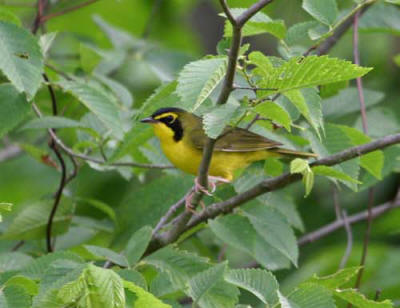 In spring, Brookside often attracts a couple of “southeastern” songbirds. Some of the representatives recorded here include Acadian Flycatcher, White-eyed Vireo, Blue-winged Warbler, Yellow-throated Warbler, Cerulean Warbler, Prothonotary Warbler, Worm-eating Warbler, Kentucky Warbler, Hooded Warbler, and Summer Tanager (Dinsmore and Zaletel 2001). All of these species summer in southern and/or eastern Iowa but are less numerous in the rest of the state (Kent and Dinsmore 1996). A few individuals seen at Brookside are probably stopping along the edge of their usual migration paths to the north. However, many are likely over-migrants, or birds that have traveled beyond the usual known limits of their nesting range. Although most of these species are not guaranteed in a given spring at Brookside, suitable fallout conditions frequently produce one or two of the group. As in much of the state, Kentucky Warbler, Hooded Warbler, and Summer Tanager are particularly strong over-migrants that are currently the most likely to be found. Southeastern species are also seen at Brookside in fall, especially hatch-year birds, but not nearly as often. Again, the riparian woodland in the northern half of the park is the place to seek out these birds during migration.
In spring, Brookside often attracts a couple of “southeastern” songbirds. Some of the representatives recorded here include Acadian Flycatcher, White-eyed Vireo, Blue-winged Warbler, Yellow-throated Warbler, Cerulean Warbler, Prothonotary Warbler, Worm-eating Warbler, Kentucky Warbler, Hooded Warbler, and Summer Tanager (Dinsmore and Zaletel 2001). All of these species summer in southern and/or eastern Iowa but are less numerous in the rest of the state (Kent and Dinsmore 1996). A few individuals seen at Brookside are probably stopping along the edge of their usual migration paths to the north. However, many are likely over-migrants, or birds that have traveled beyond the usual known limits of their nesting range. Although most of these species are not guaranteed in a given spring at Brookside, suitable fallout conditions frequently produce one or two of the group. As in much of the state, Kentucky Warbler, Hooded Warbler, and Summer Tanager are particularly strong over-migrants that are currently the most likely to be found. Southeastern species are also seen at Brookside in fall, especially hatch-year birds, but not nearly as often. Again, the riparian woodland in the northern half of the park is the place to seek out these birds during migration.
While spring is the best time for southeastern species, fall is the season in which Brookside has produced another interesting bird –– the Black-throated Blue Warbler. Recently, this richly colored rarity has been observed on an almost yearly basis at Brookside from late August through October. Each of the black-throated blues that I’ve seen here was foraging in the southeastern part of the woods, just west of the paved path. The shaded, vine-laden tangles in the lower reaches of this section, which is bordered by the aforementioned “wall,” present a nice refuge for migrant black-throated blues. Another suitable place to check for this species is the similarly dense habitat along Squaw Creek, such as the periphery of the streamside meadow.
One typical aspect of wooded urban parks that Brookside lacks is a significant number of conifer plantings, aside from a few pines in the southern part of the park. Nonetheless, Pine Warblers have frequented the area on several occasions during migration. Sifting through mixed-species flocks in just about any part of the park could yield a sighting.
WANDERERS FROM THE WEST
Perhaps the most interesting indicator of Brookside’s capacity to attract wandering birds was the one-day appearance of an Acorn Woodpecker in 2005 (to be featured in the next issue). This was not only Iowa’s first record, but also the easternmost documented occurrence of the species in North America (Ann Johnson, pers. comm., 2006). Other western itinerants observed at the park include Lazuli Bunting (spring 2002), Spotted Towhee (fall 2003), Varied Thrush (fall 2003), and a pacificus-type Winter Wren (fall 2003).
Although just about any of Iowa’s recorded (or yet-to-be recorded!) forest species could show up at Brookside, Varied Thrush is a rare migrant that the park seems particularly well equipped to attract. The woodland’s verdant understory could provide a welcome refuge for another Varied Thrush. Outside the woods, scattered ornamental fruit trees could lure a Bohemian Waxwing during irruption years.
THE NESTING SEASON
The birding activity at Brookside slows considerably during June and July, as most of the energetic migrants have moved on. Brookside on its own isn’t large enough to hold a good diversity of nesting birds. For sure, the park’s best feature is its ability to attract these migrants on their way to and from the boreal and mixed forests to the north. However, a few birds remain at Brookside to nest.
In mid- to late May, you’re sure to see and hear Indigo Buntings, which often set up territories in the northern part of the park. Thickets near Squaw Creek and gaps in the woodland usually host nesting Indigo Buntings in the summer months. Look for broods or family groups from July to early September. Of course, this is also an effective means of finding young Brown-headed Cowbirds.
Other species found during summer include familiar birds like Wood Duck, Eastern Wood-Pewee, Great Crested Flycatcher, House Wren, American Robin, Gray Catbird, and Common Yellowthroat. Eastern Phoebes nest underneath bridges near the park, and juveniles are readily seen in summer and early fall. Also look for pairs of Northern Rough-winged Swallows along steep banks of Squaw Creek, especially in the northern part of the park. Moreover, on spring days when migrant numbers are a bit low, one can pass time watching woodpeckers (red-bellied, downy, hairy, and Northern Flicker), Black-capped Chickadees, and White-breasted Nuthatches tending to early-season nesting duties.
Tufted Titmouse and Carolina Wren were new additions to central Iowa’s avifauna in the twentieth century (Kent and Dinsmore 1996; Dinsmore and Zaletel 2001). Both are now seen (but mostly heard!) around Brookside on a regular basis. The latter almost certainly nests in the wooded neighborhood to the east and may do so within the park. These two, along with Black-capped Chickadee, White-breasted Nuthatch, and Northern Cardinal can be heard singing in the area at just about any time of year, even on chilly winter days. Likewise, resident Barred Owls vocalize year round and probably raise young in the vicinity.
A fairly recent phenomenon of Brookside’s nesting season is that of Cooper’s Hawks. Nesting, which has been observed at Brookside in several recent years, commences in April or May and extends into the summer months. Look for stick nests positioned in the upper reaches of large trees, especially in the quieter western half of the woods. Observing these raptors from a comfortable distance is definitely a worthwhile experience. The presence of Cooper’s Hawks, however, does put a damper on songbird activity in the occupied part of the park. Therefore, I concentrate much of my springtime birding away from a nest’s vicinity, both for better birding and for the best interests of the hawks.
PARTING THOUGHTS
Keep in mind that the southern portion of Brookside is multi-use in design. Hundreds of people are sometimes present on warmer days and weekends, enjoying the array of amenities that the park has to offer. However, once I reach the woodland trails, the park takes on a more isolated feel. Again, though, please stay on the trails and do what you can to keep the woods a quiet place to visit.
Each year, Brookside delivers several great migration days with some less successful outings thrown into the mix. Productive times of birding in the park often involve lots of listening and waiting. Hopefully, this article will enable you to better maximize your time if you happen to visit. I do encourage birders to stop by Brookside if in central Iowa, especially because of the park’s proximity to the ISU campus and the major freeways along Ames. Of course, I would be happy to learn of what you find on a birding trip. Finally, I encourage everyone to contribute any interesting sightings to the Iowa Ornithologists’ Union’s seasonal field reports, which can be found on the Iowa Birds and Birding web site at www.iowabirds.org.
ACKNOWLEDGEMENTS
I thank Katy Patterson for comments on previous drafts of this article. I also thank the many Brookside birders –– past and present –– whose findings have motivated me to explore and write about this park.
LITERATURE CITED
Dinsmore, S. J. and H. Zaletel. 2001. The Birds of Story County, Iowa. 3rd ed. Published by the authors, Ames, Iowa. 42 pp.
Fix, A. S. 1990. Birding madness at Brookside Park, Ames. Iowa Bird Life 60:76–77.
Kent, T. H. and J. J. Dinsmore. 1996. Birds in Iowa. Published by the authors, Iowa City and Ames.
Martsching, P. 1986. Spring warbler migration at Brookside Park in Ames. Iowa Bird Life 56:107–111.
Martsching, P. 1987. Fall warbler migration at Brookside Park in Ames. Iowa Bird Life 57:112–117.